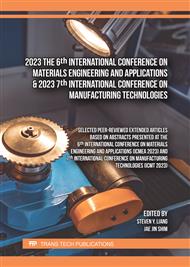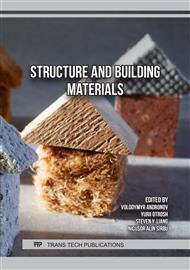[1]
Pinto Junior, L. A. B.; Berger, A. P. L.; Junca, E.; Grillo, F. F.; Sampaio, N. P.; Oliveira, J., 2016. Characterization of basic oxygen furnace slag and granite waste mixtures to Portland cement production. Metallurgy and materials, 69(4), pp.459-464.
DOI: 10.1590/0370-44672016690046
Google Scholar
[2]
Sabour, M. R., Derhamjani, G., Akbari, M. & Hatami, A. M., 2021. Global trends and status in waste foundry sand management. Environmental Science and Pollution Research research during the years 1971-2020: a systematic analysis, Volume 28, pp.37312-37321.
DOI: 10.1007/s11356-021-13251-8
Google Scholar
[3]
Zhang, N., Wu, L., Liu, X. & Zhang, Y., 2019. Structural characteristics and cementitious behavior of basic oxygen furnace slag mud and electric arc furnace slag. Construction and Building Materials, Volume 219, pp.11-18.
DOI: 10.1016/j.conbuildmat.2019.05.156
Google Scholar
[4]
Mashifana, T. & Sithole, T., 2020. Recovery of Silicon Dioxide from Waste Foundry Sand and Alkaline Activation of Desilicated Foundry Sand. Journal of Sustainable Metallurgy, Volume 6, pp.700-714.
DOI: 10.1007/s40831-020-00303-5
Google Scholar
[5]
Nyembwe, J. K., Makhatha, M. E., Madzivhandila, T. & Nyembwe, K. D., 2015. Characterisation of South African Waste Foundry Moulding Sand: Metallic Contaminents. Barcelona, Proceedings of the World Congress on Mechanical, Chemical, and Material Engineering (MCM 2015).
DOI: 10.4186/ej.2016.20.5.35
Google Scholar
[6]
Nunes, V. A. & Borges, P. H. R., 2021. Recent advances in the reuse of steel slags and future perspectives as binder and aggregate for alkali-activated materials. Construction and Building Materials, Volume 281.
DOI: 10.1016/j.conbuildmat.2021.122605
Google Scholar
[7]
Chen, Y.-L. & Lin, C.-T., 2020. Recycling of Basic Oxygen Furnace Slag as a Raw Material for Autoclaved Aerated Concrete Production. Sustainability, 12(5896), pp.1-13.
DOI: 10.3390/su12155896
Google Scholar
[8]
Carvalho, S. Z. Vernilli, F.; Almeida, B.; Oliveira, M D.; Silva, S N., 2018. Reducing environmental impacts: The use of basic oxygen furnace slag in portland cement. Journal of Cleaner Production, Volume 172, pp.385-390.
DOI: 10.1016/j.jclepro.2017.10.130
Google Scholar
[9]
Bodor, M.; Santos, R.M.; Salman, M.; Cizer, Ozlem; Iacobescu, R.I.; Chiang, Yi W.; Balen, K.; Vlad, M.; Gerven, T., 2016. Laboratory investigation of carbonated BOF slag used as partial replacement of natural aggregate in cement mortars. Cement and Concrete Composites, Volume 65, pp.55-66.
DOI: 10.1016/j.cemconcomp.2015.10.002
Google Scholar
[10]
Kambole, C.; Paige-Green, P.; Kupolati, W. K.; Ndambuki, J. M.; Adeboje, A. O., 2017. Basic oxygen furnace slag for road pavements: A review of material characteristics and performance for effective utilisation in southern Africa. Construction and Building Materials, Volume 148, pp.618-631.
DOI: 10.1016/j.conbuildmat.2017.05.036
Google Scholar
[11]
Kang, G.; Cikmit, A. A.; Tsuchida, T.; Honda, H.; Young-sang, K., 2019. Strength development and microstructural characteristics of soft dredged clay stabilized with basic oxygen furnace steel slag. Construction and Building Materials, Volume 203, pp.501-513.
DOI: 10.1016/j.conbuildmat.2019.01.106
Google Scholar
[12]
Kim, S. H., Jeong, S., Chung, H. & Nam, K., 2018. Stabilization mechanism of arsenic in mine waste using basic oxygen furnace slag: The role of water contents on stabilization efficiency. Chemosphere, Volume 208, pp.916-921.
DOI: 10.1016/j.chemosphere.2018.05.173
Google Scholar
[13]
Kim, S. H., Jeong, S., Chung, H. & Nam, K., 2018. Stabilization mechanism of arsenic in mine waste using basic oxygen furnace slag: The role of water contents on stabilization efficiency. Chemosphere, Volume 208, pp.916-921.
DOI: 10.1016/j.chemosphere.2018.05.173
Google Scholar
[14]
Park, C.-L., Kim, B.-G. & Yu, Y., 2012. The regeneration of waste foundry sand and residue stabilization using coal refuse. Journal of Hazardous Materials, Volume 203-204, pp.176-182.
DOI: 10.1016/j.jhazmat.2011.11.100
Google Scholar
[15]
Nyembwe, J. K., Makhatha, M. E., Banganay, F. C. & Nyembwe, K., 2018. Characterization of Foundry Waste Sand Streams for Recycling Applications in Construction Industry. Waste Biomass Valor , Volume 9, pp.1681-1686.
DOI: 10.1007/s12649-017-9894-0
Google Scholar
[16]
Iloh, P., Fanourakis, G. & Ogra, A., 2019. Evaluation of Physical and Chemical Properties of South African Waste Foundry Sand (WFS) for Concrete Use. Sustainability, 193(11).
DOI: 10.3390/su11010193
Google Scholar
[17]
Sithole, N. T., 2018. Synthesis and evaluation of slag based geopolymers for acidic mineral effluent remediation and geotechnical engineering applications, Johannesburg: University of Johannesburg.
Google Scholar
[18]
Apithanyasai, S., Supakata, N. & Papong, S., 2020. The potential of industrial waste: using foundry san with fly ash and electric arc furnace slag for geopolymer brick production. Heliyon, Volume 66.
DOI: 10.1016/j.heliyon.2020.e03697
Google Scholar
[19]
Ahmed, M.M. El-Naggar, K.A.M; Tarek, D.; Ragab, A.; Sameh, H.; Zeyad, A. M.; Tayeh, B.A.; Maafa, I.M.; Yousef, Ayman., 2021. Fabrication of thermal insulation geopolymer bricks using ferrosilicon slag and alumina waste. Case Studies in Construction Materials, Volume 15.
DOI: 10.1016/j.cscm.2021.e00737
Google Scholar
[20]
Hossiney, N., Das, P., Mohan, M. K. & George, J., 2018. In-plant production of bricks containing waste foundry sand-A study with Belgaum foundry industry. Case Studies in Construction Materials, Volume 9.
DOI: 10.1016/j.cscm.2018.e00170
Google Scholar
[21]
Xu, W., Li, Q. & Liu, B., 2020. Coupled effect of curing temperature and age on compressive behaviour, microstructure and ultrasonic properties of cemented tailings backfill. Construction and Building Materials, Volume 237.
DOI: 10.1016/j.conbuildmat.2019.117738
Google Scholar
[22]
Falayi, T., 2020. A comparison between fy ash- and basic oxygen furnace slag-modifed gold mine tailings geopolymers. International Journal of Energy and Environmental Engineering, Volume 11, pp.207-217.
DOI: 10.1007/s40095-019-00328-x
Google Scholar



